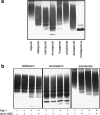Characterization of anticoagulant heparinoids by immunoprofiling
- PMID: 17909966
- PMCID: PMC2234449
- DOI: 10.1007/s10719-007-9070-z
Characterization of anticoagulant heparinoids by immunoprofiling
Abstract
Heparinoids are used in the clinic as anticoagulants. A specific pentasaccharide in heparinoids activates antithrombin III, resulting in inactivation of factor Xa and-when additional saccharides are present-inactivation of factor IIa. Structural and functional analysis of the heterogeneous heparinoids generally requires advanced equipment, is time consuming, and needs (extensive) sample preparation. In this study, a novel and fast method for the characterization of heparinoids is introduced based on reactivity with nine unique anti-heparin antibodies. Eight heparinoids were biochemically analyzed by electrophoresis and their reactivity with domain-specific anti-heparin antibodies was established by ELISA. Each heparinoid displayed a distinct immunoprofile matching its structural characteristics. The immunoprofile could also be linked to biological characteristics, such as the anti-Xa/anti-IIa ratio, which was reflected by reactivity of the heparinoids with antibodies HS4C3 (indicative for 3-O-sulfates) and HS4E4 (indicative for domains allowing anti-factor IIa activity). In addition, the immunoprofile could be indicative for heparinoid-induced side-effects, such as heparin-induced thrombocytopenia, as illustrated by reactivity with antibody NS4F5, which defines a very high sulfated domain. In conclusion, immunoprofiling provides a novel, fast, and simple methodology for the characterization of heparinoids, and allows high-throughput screening of (new) heparinoids for defined structural and biological characteristics.
Figures



Similar articles
-
Heparinoid Complex-Based Heparin-Binding Cytokines and Cell Delivery Carriers.Molecules. 2019 Dec 17;24(24):4630. doi: 10.3390/molecules24244630. Molecules. 2019. PMID: 31861225 Free PMC article. Review.
-
Heparinoids Danaparoid and Sulodexide as clinically used drugs.Prog Mol Biol Transl Sci. 2019;163:55-74. doi: 10.1016/bs.pmbts.2019.02.005. Epub 2019 Mar 21. Prog Mol Biol Transl Sci. 2019. PMID: 31030761 Review.
-
The potential for circular dichroism as an additional facile and sensitive method of monitoring low-molecular-weight heparins and heparinoids.Thromb Haemost. 2009 Nov;102(5):874-8. doi: 10.1160/TH08-12-0797. Thromb Haemost. 2009. PMID: 19888522
-
Anticoagulation with recombinant hirudin following bone marrow transplantation in a patient with activated protein C resistance and heparin-induced antibodies showing cross-reactivity to the heparinoid danaparoid.Med Pediatr Oncol. 1999 Jun;32(6):457-8. doi: 10.1002/(sici)1096-911x(199906)32:6<457::aid-mpo16>3.0.co;2-n. Med Pediatr Oncol. 1999. PMID: 10358710 No abstract available.
-
Heparin-induced thrombocytopenia: IgG binding to PF4-heparin complexes in the fluid phase and cross-reactivity with low molecular weight heparin and heparinoid.Thromb Haemost. 1998 Aug;80(2):292-7. Thromb Haemost. 1998. PMID: 9716155
Cited by
-
Role of the Extracellular Matrix in Alzheimer's Disease.Front Aging Neurosci. 2021 Aug 27;13:707466. doi: 10.3389/fnagi.2021.707466. eCollection 2021. Front Aging Neurosci. 2021. PMID: 34512308 Free PMC article. Review.
-
Imaging Glycosaminoglycan Modification Patterns In Vivo.Methods Mol Biol. 2022;2303:539-557. doi: 10.1007/978-1-0716-1398-6_42. Methods Mol Biol. 2022. PMID: 34626406
-
Characterization of the interaction between the chlamydial adhesin OmcB and the human host cell.J Bacteriol. 2013 Dec;195(23):5323-33. doi: 10.1128/JB.00780-13. Epub 2013 Sep 20. J Bacteriol. 2013. PMID: 24056107 Free PMC article.
-
In vivo molecular imaging of peripheral amyloidosis using heparin-binding peptides.Proc Natl Acad Sci U S A. 2011 Aug 23;108(34):E586-94. doi: 10.1073/pnas.1103247108. Epub 2011 Aug 1. Proc Natl Acad Sci U S A. 2011. PMID: 21807994 Free PMC article.
-
Mapping the differential distribution of glycosaminoglycans in the adult human retina, choroid, and sclera.Invest Ophthalmol Vis Sci. 2011 Aug 17;52(9):6511-21. doi: 10.1167/iovs.11-7909. Invest Ophthalmol Vis Sci. 2011. PMID: 21746802 Free PMC article.
References
-
- {'text': '', 'ref_index': 1, 'ids': [{'type': 'PubMed', 'value': '16299683', 'is_inner': True, 'url': 'https://pubmed.ncbi.nlm.nih.gov/16299683/'}]}
- Achour A., Kacem M., Dibej K., Skhiri H., Bouraoui S., El May M.: One year course of oral sulodexide in the management of diabetic nephropathy. J. Nephrol. 18, 568–574 (2005) - PubMed
-
- {'text': '', 'ref_index': 1, 'ids': [{'type': 'DOI', 'value': '10.1111/j.1365-2141.2005.05953.x', 'is_inner': False, 'url': 'https://doi.org/10.1111/j.1365-2141.2005.05953.x'}, {'type': 'PubMed', 'value': '16512825', 'is_inner': True, 'url': 'https://pubmed.ncbi.nlm.nih.gov/16512825/'}]}
- Baglin T., Barrowcliffe T.W., Cohen A., Greaves M.: Guidelines on the use and monitoring of heparin. Br. J. Haematol. 133, 19–34 (2006) - PubMed
-
- {'text': '', 'ref_index': 1, 'ids': [{'type': 'DOI', 'value': '10.1016/j.biopha.2003.11.007', 'is_inner': False, 'url': 'https://doi.org/10.1016/j.biopha.2003.11.007'}, {'type': 'PubMed', 'value': '15183845', 'is_inner': True, 'url': 'https://pubmed.ncbi.nlm.nih.gov/15183845/'}]}
- Bobek V., Kovarik J.: Antitumor and antimetastatic effect of warfarin and heparins. Biomed. Pharmacother. 58, 213–219 (2004) - PubMed
-
- {'text': '', 'ref_index': 1, 'ids': [{'type': 'PubMed', 'value': '10549712', 'is_inner': True, 'url': 'https://pubmed.ncbi.nlm.nih.gov/10549712/'}]}
- Casu B., Torri G.: Structural characterization of low molecular weight heparins. Semin. Thromb. Hemost. 25(Suppl 3), 17–25 (1999) - PubMed
-
- {'text': '', 'ref_index': 1, 'ids': [{'type': 'DOI', 'value': '10.1016/S0149-2918(02)80077-7', 'is_inner': False, 'url': 'https://doi.org/10.1016/s0149-2918(02)80077-7'}, {'type': 'PubMed', 'value': '12501872', 'is_inner': True, 'url': 'https://pubmed.ncbi.nlm.nih.gov/12501872/'}]}
- Cheng J.W.: Fondaparinux: a new antithrombotic agent. Clin. Ther. 24, 1757–1769 (2002) - PubMed
Publication types
MeSH terms
Substances
LinkOut - more resources
Full Text Sources
Other Literature Sources
Medical

